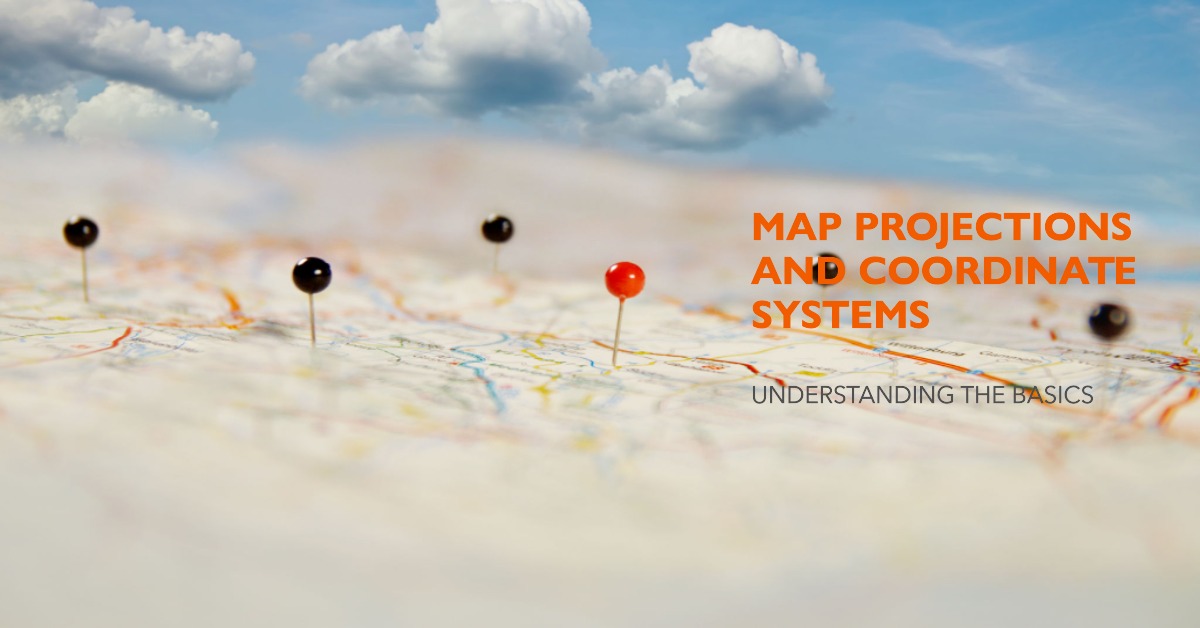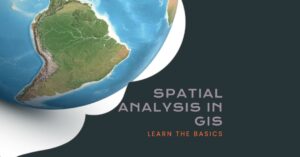Introduction
Geographic Information Systems (GIS) are critical in mapping and spatial analysis in today’s digital environment. Geographic data can be visualized, interpreted, and analyzed using GIS. Understanding map projections and coordinate systems is a crucial part of GIS. In this post, we will look at the fundamentals of map projections and coordinate systems, as well as their significance and impact on GIS applications.
What is GIS?
Definition
A Geographic Information System (GIS) is a system that collects, stores, maintains, analyzes, and displays spatial or geographical data. It combines data from a variety of sources, including satellite imagery, aerial pictures, GPS data, and maps, to generate a comprehensive view of geographic information.
Applications
GIS has numerous uses in a variety of industries. It is applied in many different disciplines, including urban planning, environmental management, transportation, natural resource management, disaster response, and many more. Professionals can use GIS to make informed decisions based on spatial data analysis.
Map Projections
Map projections are methods for representing the Earth’s curving surface on a flat map. Because the Earth is a three-dimensional object, it is impossible to adequately show it on a two-dimensional map without distortion. Map projections aid in the reduction of distortion and the representation of the Earth’s surface in a legible way.
Purpose
The purpose of map projections is to provide an accurate representation of geographic features on a flat surface. Different map projections are designed to emphasize specific aspects, such as preserving shapes, areas, distances, or directions.
Types
There are various types of map projections, each with its unique characteristics. Some common types include:
- Cylindrical projections involve wrapping a cylinder around the Earth and projecting the surface onto it. The Mercator projection, Miller projection, and Transverse Mercator projection are among examples.
- Conic Projections: Conic projections project the Earth’s surface using a cone. They are frequently used to map mid-latitude regions. Lambert Conformal Conic projection and Albers Equal Area Conic projection are two examples.
- Azimuthal projections are projections of the Earth’s surface onto a plane from a specific point. They are frequently used for polar maps or maps that are centered on a certain point. The Lambert Azimuthal Equal Area projection and the Stereographic projection are two examples.
Coordinate Systems
Coordinate systems are used to define the location of geographic features on a map or within a geographic information system (GIS). They provide a framework of reference points that allows us to precisely locate and measure objects. Coordinate systems and map projections work together to form a comprehensive spatial reference system.
Importance
GIS relies on coordinate systems to provide accurate geographical analysis and data integration. They provide a consistent means of representing locations on the Earth’s surface, allowing different data sources to be aligned and studied in conjunction. Spatial data would be difficult to analyze and use efficiently without a standardized coordinate system.
Common Systems
There are two main types of coordinate systems: geographic coordinate systems (GCS) and projected coordinate systems (PCS).
- Geographic Coordinate Systems (GCS): GCS define places on the Earth’s surface using latitude and longitude. Longitude is measured east or west of the Prime Meridian, while latitude is measured north or south of the Equator. The World Geodetic System (WGS84) is the most widely used GCS.
- PCS (Projected Coordinate Systems): PCS are two-dimensional Cartesian coordinate systems. They depict locations on a flat map with x and y coordinates. PCS are commonly used for local or regional mapping since they are designed to reduce distortion within a specific area or region.
Understanding Map Projections and Coordinate Systems
Relationship between Map Projections and Coordinate Systems
Map projections and coordinate systems are inextricably linked. A coordinate system serves as a framework for finding geographic features, but a map projection specifies how those features are depicted on a map.
When working with GIS, it is critical to choose a coordinate system that corresponds to the map projection you intend to utilize. This provides correct data representation and the preservation of spatial links throughout analysis.
How Map Projections Work
Map projections involve mathematically transforming the Earth’s spherical surface onto a flat plane. This transformation introduces distortion, and different projections handle distortion differently based on their specific properties.
Each map projection has advantages and disadvantages depending on the map’s function and the region being portrayed. Some projections accurately preserve shape but distort size, while others accurately preserve areas but sacrifice shape or direction. The projection to employ depends on the map’s intended usage and the area to be mapped.
Challenges and Considerations
Working with map projections and coordinate systems can present challenges. It is essential to understand the limitations and potential issues associated with different projections and coordinate systems. Some common challenges include:
- All map projections introduce some degree of distortion. When selecting a projection for a certain purpose, it is critical to examine the type and level of distortion that may occur.
- Map projections can change the scale of a map, affecting measurements and distances. Understanding scale factors and choosing proper projections are critical for performing correct spatial analysis.
- Datum Transformation: Datum is the mathematical model used to define the shape and size of the Earth. When working with disparate coordinate systems, datum transformation may be required to guarantee that datasets are aligned.
Choosing the Right Projection and Coordinate System
The appropriate map projection and coordinate system are determined by a number of criteria, including the map’s purpose, geographic extent, and accuracy needs. Here are some things to think about when making your decision:
- Purpose: Determine the intended use of the map. Are you creating a thematic map for visualizing patterns, or do you require precise measurements and calculations?
- Geographic Extent: Consider the size and location of the area you are mapping. Different projections are better suited for specific regions, such as global maps or maps focused on a particular country or city.
- Data Compatibility: Ensure that the coordinate system and projection you choose are compatible with the datasets you plan to use. Coordinate transformation may be required to align datasets with different coordinate systems.
Popular Map Projections and Coordinate Systems
Mercator Projection
One of the most well-known and extensively used map projections is the Mercator projection. It accurately preserves angles and shapes, making it useful for navigation and seafaring needs. However, when you move away from the Equator, it distorts the scale and relative distance of objects, resulting in exaggerated landmasses at the poles.
Lambert Conformal Conic Projection
The Lambert Conformal Conic projection is often used to map medium- to large-scale areas such as states or regions. It preserves both conformality (angles and forms) and conformity (local shapes). This projection is commonly used to map countries, continents, and large-scale regional maps.
Universal Transverse Mercator (UTM)
The UTM projection divides the Earth into 60 zones, each 6 degrees longitude broad. It is widely employed in both military and civilian purposes, particularly large-scale mapping and precise location. The UTM projection reduces distortion and offers accurate measurements inside each zone.
Best Practices for Working with GIS and Map Projections
To effectively work with GIS and map projections, it is important to follow some best practices:
Collecting and Preparing Data
Ensure that all data used in your GIS project has a defined coordinate system and projection. Accurate metadata and documentation help maintain data integrity and prevent misinterpretation.
Defining Projection and Coordinate System
Clearly define and document the coordinate system and projection used in your GIS project. This information should be easily accessible to anyone working with the data to ensure consistency and accurate analysis.
Managing Coordinate Transformation
If working with datasets in different coordinate systems, perform coordinate transformations to ensure alignment. Utilize appropriate GIS tools and techniques to minimize errors during the transformation process.
Conclusion
Anyone working with GIS and spatial analysis should be familiar with map projections and coordinate systems. Map projections allow us to portray the Earth’s curved surface on a flat map, whereas coordinate systems provide a framework for finding geographic features accurately. We can assure accurate spatial analysis and meaningful data interpretation in GIS applications by selecting the appropriate projection and coordinate system and adhering to best practices.
FAQs
What is the purpose of map projections?
- Map projections allow us to represent the Earth’s curved surface on a flat map, providing an accurate depiction of geographic features.
How do coordinate systems help in GIS?
- Coordinate systems provide a framework for locating geographic features on a map or within a GIS, enabling accurate spatial analysis and data integration.
How do I choose the right map projection?
- The choice of map projection depends on factors such as the purpose of the map, geographic extent, and accuracy requirements. Consider the intended use and characteristics of the area being mapped.
What challenges can arise when working with map projections?
- Challenges include distortion, scale variations, and the need for datum transformations when working with different coordinate systems.
What are some popular map projections?
- Popular map projections include the Mercator projection, Lambert Conformal Conic projection, and Universal Transverse Mercator (UTM) projection.



